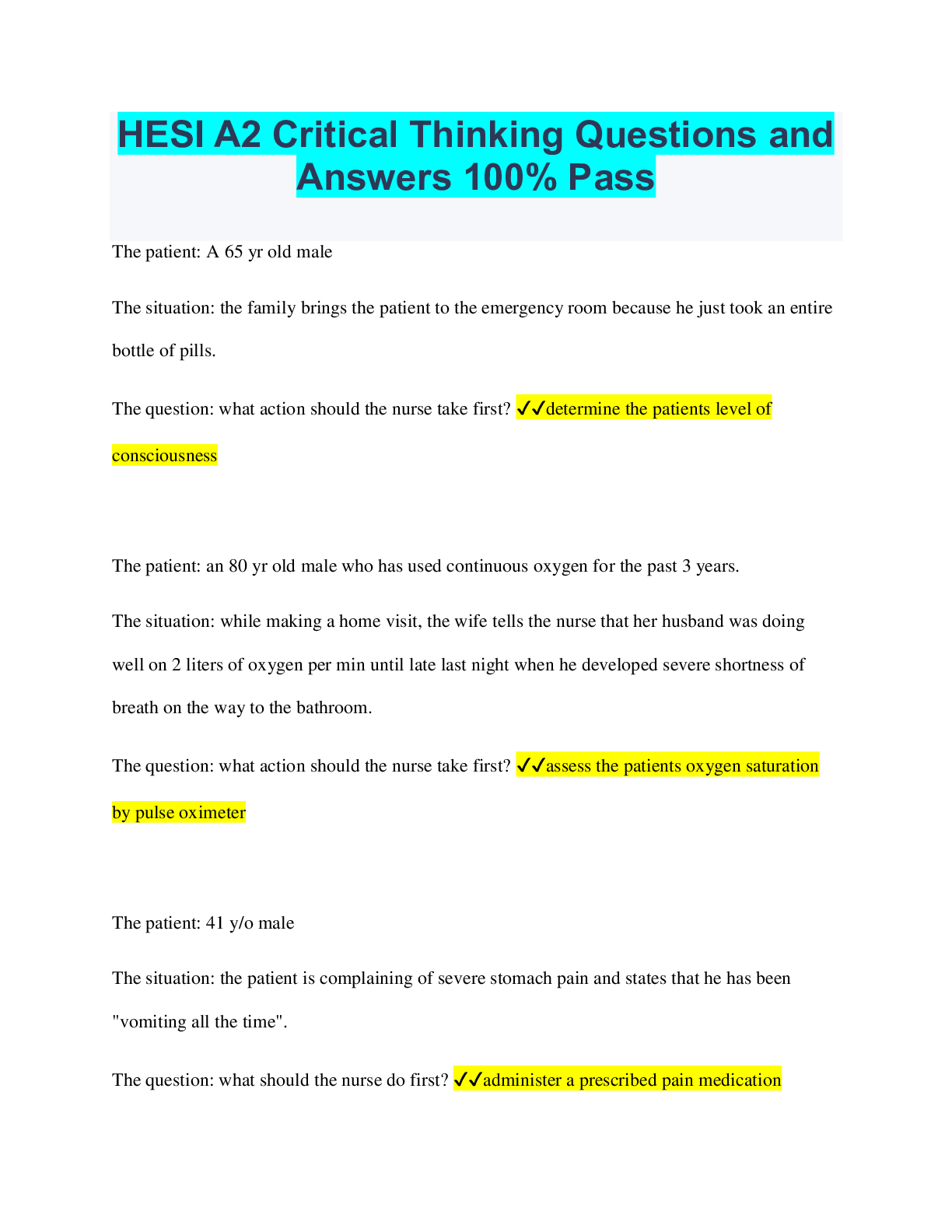Animal Management > QUESTIONS & ANSWERS > ANSC 100 UIUC ; Nutrition (All)
ANSC 100 UIUC ; Nutrition
Document Content and Description Below
ANSC 100 UIUC ; Nutrition The digestive tract of a _____ is most similar to humans. Cow Sheep Horse Pig - ✔✔Pig Rumen bacteria produce _____ that the animal uses for energy. Minerals Oils ... Volatile fatty acids (VFA) Carbohydrates - ✔✔Volatile fatty acids (VFA) Which of the following means "the process of making food absorbable by mechanically and enzymatically breaking it down into simpler chemical compounds? Digestion Metabolism Rumination Absorption - ✔✔Digestion One example of Saccharide is: Cellulose Starch Pectin Fructose - ✔✔Fructose A beef cow consumes 30 lbs. of grass hay(as-fed basis) daily. The grass hay is 80% dry matter. How much dry matter from the hay is she consuming? 18 28 16 24 - ✔✔24 Which of the following is NOT involved in rumination? Remastication Eructation Absorption Deglutition Regurgitation - ✔✔Absorption If an animal consumed 5kg of protein and produced feces containing 2kg of protein, the apparent digestibility of the protein would be: 40% 60% 30% 50% - ✔✔60% _____ is the process of expelling gas from the rumen. Rumination Digestion Eructation Regurgitation - ✔✔Eructation The melting point of saturated fats are higher than those of unsaturated fats. True or False - ✔✔True Energy is a nutrient True/ False - ✔✔False The primary function of dietary fat is to: Be used for energy Provide osmotic balance Act as cofactors in reactions Make protein - ✔✔Be used for energy The primary function of dietary carbohydrates is to: Provide energy Make protein Provide osmotic balance Act as cofactors in reactions - ✔✔Provide energy ____ occurs in the stomach of monogastric animals. Storage of ingested feed Physical breakdown of feed Absorption of nutrients Both A and B Both B and C - ✔✔Both A and B Animals do not have a specific requirement for protein. True or False - ✔✔True ___ is an example of a carbohydrate Copper Glucose Water Acetate - ✔✔Glucose The advantage of ruminants over non-ruminants is their ability yo use: Oils Concentrates Roughage or Forages Minerals - ✔✔Roughage or Forages The acid detergent fiber (ADF) method measures all of the following except _______. Cellulose Pectin Lignin Hemicellulose All of the above - ✔✔Hemicellulose Net energy is equal to: Gross energy - Fecal energy Gross energy- Fecal energy and Urinary/Gas energy Metabolizable energy - Energy lost as heat Gross energy - net energy - ✔✔Metabolizable energy - Energy lost as heat ___ is the nutrient that is most critical for animal survival. Minerals Energy Carbohydrates Water - ✔✔Water Which of the following ingredients contains the most energy for animals? Hay Silage Corn Oat Straw - ✔✔Corn The ____ is responsible for mechanical digestion in the avian digestive tract. Cloaca Crop Gizzard Provintriculus - ✔✔Gizzard To calculate nitrogen from crude protein (CP), one should: Multiply CP by 6.25 Divide CP by 16 Divide CP by 6.25 Multiply CP by 16 - ✔✔Divide CP by 16 A ruminant animal converts carbohydrates to which of the following in the rumen? Proteins Minerals Acetate Butterate - ✔✔Acetate The animal with the largest proportion of its gastrointesinal tract in the large intestine is: Pig Horse Two of these are the same Sheep - ✔✔Horse Digestible energy is equal to: Gross Energy - Net Energy Gross Energy - Fecal Energy and Urinary/Gas Energy Net Energy - Urinary/Gas Energy Gross Energy- Fecal Energy - ✔✔Gross Energy- Fecal Energy The acid detergent fiber (NDF) method m [Show More]
Last updated: 2 years ago
Preview 1 out of 6 pages

Buy this document to get the full access instantly
Instant Download Access after purchase
Buy NowInstant download
We Accept:

Reviews( 0 )
$8.00
Can't find what you want? Try our AI powered Search
Document information
Connected school, study & course
About the document
Uploaded On
Jul 08, 2022
Number of pages
6
Written in
Additional information
This document has been written for:
Uploaded
Jul 08, 2022
Downloads
0
Views
135














